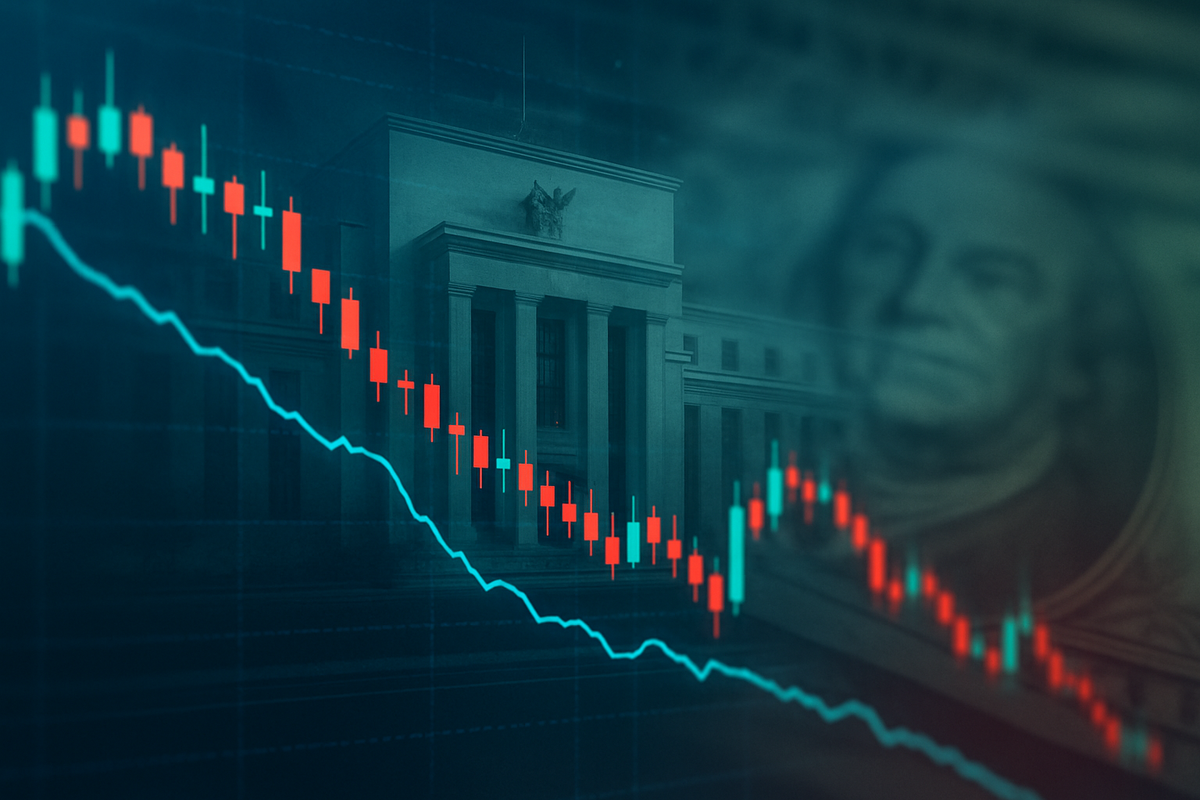
The financial markets are abuzz with intensified expectations for a September interest rate cut by the Federal Reserve. This anticipation has triggered a significant reaction in the bond market, most notably a sharp tumble in Treasury yields and a broad weakening of the U.S. dollar. This immediate market response reflects a profound shift in investor sentiment, largely driven by recent dovish signals from Federal Reserve Chair Jerome Powell, suggesting a proactive stance to support economic growth amidst evolving risks.
The implications are far-reaching, signaling an easing of financial conditions that could stimulate borrowing, investment, and consumer spending. However, it also introduces new dynamics for various sectors, from export-oriented companies to real estate, and poses challenges for savers and some financial institutions. The market is now firmly pricing in a high probability of a 25-basis-point reduction, setting the stage for a pivotal Federal Open Market Committee (FOMC) meeting next month.
The Dovish Shift: What Happened and Why It Matters
The bond market's dramatic movements are a direct consequence of a series of events and statements that have collectively convinced investors that a September rate cut is not just possible, but highly probable. The most significant catalyst was Federal Reserve Chair Jerome Powell's speech at the Jackson Hole Economic Symposium on August 22, 2025. Powell acknowledged that "the baseline outlook and the shifting balance of risks may warrant adjusting our policy stance," highlighting growing downside risks to the labor market and persistent inflation risks from tariffs. This statement was widely interpreted as a clear signal for an imminent rate cut.
Leading up to Powell's speech, earlier economic data had already laid the groundwork for this shift. In early August, the Bureau of Labor Statistics released a substantial downward revision in payroll employment, showing monthly job growth since May falling to an average of 35,000—the largest downward revision since the COVID-19 pandemic. This signaled a potential cooling of the economy. Further reinforcing this view, softer-than-expected U.S. inflation data, specifically the Consumer Price Index (CPI) for July, was released on August 13, providing the Fed with more room to ease monetary policy. While some hawkish comments from other Fed officials and mixed economic data had briefly tempered expectations, Powell's Jackson Hole address solidified the market's conviction.
The bond market's reaction was swift and decisive. The benchmark 10-year Treasury yield tumbled, falling to approximately 4.25%-4.27% from 4.33% late the previous day. Even more sensitive to immediate Fed policy, the two-year Treasury yield sank notably to 3.68%-3.71% from 3.79%. This broad decline across the Treasury curve indicates that investors are anticipating lower future interest rates, making existing bonds with higher yields more attractive and driving up their prices. Concurrently, the U.S. Dollar Index (DXY), which measures the greenback's strength against a basket of major currencies, extended its losses, falling over 0.7% to below 98, trading around 97.7205 on August 22. A potential rate cut makes dollar-denominated assets less attractive to foreign investors, reducing demand for the dollar and causing its value to fall.
Key players involved in this unfolding scenario include the Federal Reserve (FOMC), whose September 16-17 meeting is now under intense scrutiny. Chair Jerome Powell's remarks were the primary driver, but internal divisions within the Fed, as evidenced by earlier dissents from governors like Michelle Bowman and Christopher Waller advocating for a rate cut, also play a role. Political pressure from figures like President Donald Trump and Treasury Secretary Scott Bessent for lower rates adds another layer of complexity. Beyond bonds and the dollar, U.S. equity markets surged, with the Dow Jones Industrial Average (NYSE: ^DJI) soaring, the S&P 500 (NYSE: ^GSPC) climbing, and the Nasdaq Composite (NASDAQ: ^IXIC) seeing strong gains. Rate-sensitive sectors like home construction and small-cap stocks, represented by the Russell 2000 (NYSE: ^RUT), led the rally. Gold prices also rebounded, reflecting expectations for a less hawkish Fed stance.
Navigating the Tides: Winners and Losers in a Lower Rate Environment
A September interest rate cut, coupled with a weakening U.S. dollar, will undoubtedly reshape the financial landscape, creating distinct advantages and disadvantages for various companies and sectors. This shift is primarily driven by changes in borrowing costs, export competitiveness, and investor sentiment.
The Winners:
Export-oriented companies and multinational corporations are poised to benefit significantly. A weaker U.S. dollar makes American goods and services more competitive in foreign markets, boosting demand and increasing revenues. For multinational giants, foreign earnings translate into more U.S. dollars when repatriated, directly improving their bottom lines. Companies like McDonald's Corporation (NYSE: MCD), Procter & Gamble Company (NYSE: PG), DuPont de Nemours (NYSE: DD), HP Inc. (NYSE: HPQ), Qualcomm (NASDAQ: QCOM), Intel (NASDAQ: INTC), Apple (NASDAQ: AAPL), Microsoft (NASDAQ: MSFT), Netflix (NASDAQ: NFLX), and Caterpillar (NYSE: CAT) are all expected to see a tailwind from these currency dynamics due to their substantial international operations.
Highly leveraged companies and small-cap stocks will also find relief. An interest rate cut directly reduces borrowing costs, particularly for those with significant debt or variable-rate loans. Small-cap companies, often carrying more debt, are especially sensitive to these changes. The Russell 2000 index is expected to see a boost, and capital-intensive businesses like AT&T (NYSE: T) with substantial debt loads can benefit from reduced interest expenses.
The real estate and home construction sectors are set for a resurgence. Lower interest rates translate directly to lower mortgage rates, making homeownership more affordable and stimulating demand. This will benefit homebuilders such as Lennar (NYSE: LEN), PulteGroup (NYSE: PHM), and D.R. Horton (NYSE: DHI), as well as construction suppliers like Builders FirstSource (NYSE: BLDR) and Mohawk Industries (NYSE: MHK).
The consumer discretionary sector is also likely to thrive. Cheaper credit encourages consumer spending on big-ticket items and non-essential goods and services. Companies like Nike (NYSE: NKE), Disney (NYSE: DIS), Airbnb (NASDAQ: ABNB), and Tesla (NASDAQ: TSLA), along with travel companies such as Norwegian Cruise Line (NYSE: NCLH), Delta Air Lines (NYSE: DAL), and Caesars Entertainment (NASDAQ: CZR), could see increased demand.
Commodity producers, particularly those dealing in gold, oil, and metals, stand to gain. Most commodities are priced in U.S. dollars, so a weakening dollar makes them cheaper for foreign buyers, typically increasing demand and pushing prices higher. Gold miners like Kinross Gold Corp. (NYSE: KGC) and Newmont (NYSE: NEM) would benefit from rising gold prices. The utilities sector, often seen as defensive dividend-payers, also becomes more attractive to income-seeking investors as bond yields fall, benefiting companies like Constellation Energy (NASDAQ: CEG) and Vistra (NYSE: VST).
The Losers:
Conversely, import-oriented companies will face headwinds. A weakening U.S. dollar makes foreign goods and services more expensive for U.S. importers, squeezing profit margins and potentially leading to higher prices for American consumers. Retailers heavily reliant on imported goods and electronics manufacturers dependent on imported components could see increased costs.
Savers and fixed-income investors will generally lose out. Banks typically reduce interest rates on savings accounts, Certificates of Deposit (CDs), and other savings products when the federal funds rate drops, diminishing returns for savers. New bond issues will also offer lower interest rates, making them less attractive for income-focused investors.
The impact on financial institutions, particularly banks, is nuanced. While lower rates can stimulate loan demand, they can also lead to narrower net interest margins (the difference between what banks earn on loans and pay on deposits), potentially reducing profitability. While some banks focused on consumer finance might benefit from increased loan volumes (e.g., First Horizon National Corporation (NYSE: FHN)), the broader banking sector could face margin compression.
Broader Implications: A Shifting Economic Landscape
The bond market's emphatic reaction to the intensified expectations of a September rate cut and the weakening U.S. dollar signifies a pivotal moment in the broader economic narrative. This event is not isolated but deeply embedded within ongoing industry trends, with potential ripple effects on competitors, partners, and significant regulatory and policy implications, drawing parallels to historical economic cycles.
The intensified expectation of a rate cut, now with probabilities nearing 90%, reflects a market belief that the Federal Reserve is pivoting towards a more accommodative stance. This easing of financial conditions is designed to stimulate economic activity, particularly in the face of slowing growth and persistent, albeit moderating, inflation. The decline in Treasury yields across the curve, especially the rate-sensitive two-year yield, and the broad weakening of the dollar, collectively signal a recalibration of investment strategies. Investors are now more inclined towards risk assets, anticipating that cheaper capital will fuel corporate expansion and consumer spending.
This shift aligns with broader industry trends where sectors sensitive to interest rates are poised for growth. The real estate sector, for instance, is expected to see a boost as lower mortgage rates enhance affordability, driving demand for housing and benefiting homebuilders and construction material suppliers. Similarly, technology and consumer discretionary sectors, often reliant on borrowing for innovation and expansion, will find capital cheaper, potentially spurring growth. Highly leveraged companies, particularly small-to-medium-sized enterprises, will experience reduced borrowing costs, improving their profitability and capacity for innovation. The commodities market, especially gold, is also likely to benefit from a weaker dollar, making dollar-denominated assets more attractive to international buyers. This environment could also ignite M&A activity across various industries, as the lower cost of capital makes acquisitions more financially viable, potentially leading to industry consolidation and new market structures.
The ripple effects will extend to the competitive landscape and global trade. A weakening U.S. dollar enhances the competitiveness of American exports, potentially boosting sales for U.S. companies in international markets. Conversely, foreign competitors selling into the U.S. might find their products more attractive due to favorable exchange rates. However, a weaker dollar can also strain emerging market economies with significant dollar-denominated debt, as their repayment burden increases. Globally, a U.S. rate cut could trigger capital flows towards higher-yielding emerging markets, influencing their currencies and monetary policy decisions.
From a regulatory and policy perspective, a September rate cut signals the Fed's commitment to its dual mandate of price stability and maximum employment, navigating a "challenging dichotomy of risks" where tariffs might increase inflation while immigration policies affect the labor market. Policymakers will need to carefully monitor inflationary pressures, as sustained low interest rates could reignite price increases. Financial stability remains a key concern, requiring robust risk management practices from institutions as loan demand potentially increases. The Fed's actions will also influence global monetary policy, with other central banks potentially adjusting their stances in response to U.S. policy divergence, especially given ongoing supply chain disruptions and trade dynamics.
Historically, Federal Reserve rate cuts have generally been bullish for stock markets, encouraging investment and consumption, and have led to price appreciation for long-term bonds. Gold prices also tend to rise in such environments. For example, during the 2008 financial crisis, gold prices surged as the Fed aggressively cut rates. However, the current context presents unique complexities, including lingering inflation concerns and the specific impact of tariffs, which were not always present in past cycles. The market's anticipation of a September cut, following a period where the Fed held rates steady, underscores the heightened sensitivity to economic data and central bank communications. While rate cuts typically aim to stimulate the economy, their effectiveness can vary, as seen in instances where previous rate hikes did not hurt the economy as much as expected due to companies and households having termed out liabilities and utilized savings. The long-term implications will depend on the Fed's subsequent actions and the evolving economic landscape, with some experts suggesting a gradual approach to further cuts into 2026.
The Road Ahead: What Comes Next
The impending September rate cut by the Federal Reserve marks a significant inflection point, ushering in a period of both short-term adjustments and long-term strategic considerations for businesses and investors alike. The market's strong reaction, characterized by tumbling Treasury yields and a weakening dollar, sets the stage for a dynamic economic environment.
In the short term, consumers can anticipate reduced borrowing costs for variable-rate loans such as credit cards and auto loans, potentially making large purchases more affordable. However, the immediate impact on fixed-rate mortgage rates might be less pronounced, as these tend to track longer-term bond yields. Savers, conversely, will likely see lower returns on savings accounts and Certificates of Deposit (CDs). For businesses, reduced borrowing costs on adjustable-rate loans will free up cash flow, which can be reinvested into operations, expansion, or mergers and acquisitions. This, coupled with potentially increased consumer spending, could boost sales across various sectors. Equity markets, particularly small-cap companies and interest-rate-sensitive sectors like real estate and financials, are historically expected to perform positively after initial rate cuts.
Looking at the long term, a key possibility is the potential for renewed inflationary pressures if rate cuts are perceived as overly aggressive or if tariffs continue to impact prices. This could lead to a challenging "stagflation" scenario, which the Federal Reserve aims to avoid. While rate cuts are intended to stimulate economic growth, a sudden economic boom is not necessarily anticipated; the Fed may aim to bring interest rates to a "neutral" level that neither boosts nor inhibits economic activity. The long-term neutral interest rate may also be higher than during the 2010s, suggesting rates might not return to pre-pandemic lows. Furthermore, lower rates can create a "wealth effect" as investment gains compound, potentially widening economic disparities. Global monetary policy divergence, with other major central banks potentially on different policy trajectories, could also influence how far U.S. yields can fall and add complexity to global market dynamics.
Strategic pivots and adaptations will be crucial. Businesses should consider refinancing existing high-interest debt, especially variable-rate loans, and revisit deferred capital projects or expansion plans. Optimizing cash flow from reduced interest payments can be reinvested into marketing or building a cash buffer. Businesses in cash-heavy sectors or those whose revenue depends on prevailing interest rates, such as banks, may need to focus on growing their client base to offset lower lending margins. Investors, meanwhile, should review and rebalance their portfolios. Overweighting equities, particularly small-cap stocks and those in rate-sensitive sectors, could be beneficial. Investment-grade corporate bonds and U.S. Treasurys may also be attractive, with adding duration in bonds potentially locking in current rates and benefiting from capital appreciation. With cash yields projected to drop, investors may need to move up the risk spectrum to maintain returns, considering commodities like gold due to geopolitical risks and potential currency debasement concerns.
Market opportunities include a lower cost of capital for businesses, increased consumer demand, potential equity market gains, and bond market appreciation. However, challenges loom, such as inflationary risks, lower returns on savings, increased competition, and potential market volatility. The risk of a recession remains if the rate cuts are a response to a weakening economy rather than a proactive measure for a "soft landing."
Ultimately, the future trajectory hinges on the underlying economic context for the rate cuts. A soft landing scenario, where inflation moderates and the labor market cools without a significant increase in unemployment, would likely see equities and bonds perform well. A recessionary scenario, where cuts are a response to a rapidly deteriorating economy, could lead to significant equity market downturns. A stagflationary scenario, with persistent inflation despite slowing growth, could see long-term bond yields rise and challenge broader market performance. Finally, a gradual normalization could lead to a prolonged period of moderate economic expansion and a more measured market response.
Conclusion: Navigating the New Monetary Landscape
The bond market's emphatic reaction to the intensified expectations of a September rate cut by the Federal Reserve marks a significant turning point in the current financial cycle. The tumble in Treasury yields and the weakening of the U.S. dollar are clear indicators of a market that has largely priced in a more accommodative monetary policy, driven by dovish signals from Federal Reserve Chair Jerome Powell and recent economic data. This shift is poised to ease financial conditions, potentially stimulating economic activity, but also introduces a complex interplay of opportunities and challenges across various sectors.
The key takeaway from this event is the Federal Reserve's apparent pivot towards a more proactive stance to support economic growth and mitigate downside risks to the labor market. This move is expected to benefit export-oriented companies, highly leveraged businesses, the real estate sector, and consumer discretionary industries through reduced borrowing costs and enhanced competitiveness. Conversely, savers and import-oriented companies will face headwinds. The broader implications include potential shifts in industry consolidation, global capital flows, and a careful balancing act for policymakers between stimulating growth and managing inflationary pressures.
Moving forward, investors should closely watch the Federal Reserve's actions and communications, particularly at the upcoming September FOMC meeting. The August jobs report and subsequent consumer and producer price index data will be crucial in shaping the Fed's decision and the market's reaction. Strategic portfolio rebalancing, with a potential overweighting of equities (especially small-caps and rate-sensitive sectors) and a careful approach to fixed income, will be essential. Businesses should seize the opportunity to refinance debt and consider capital investments, while also preparing for increased competition and potential inflationary pressures.
The lasting impact of this event will depend on whether the Fed successfully engineers a "soft landing" for the economy, or if the rate cuts are a response to a more severe downturn. While historical precedents suggest a generally bullish outlook for stocks and bonds in a rate-cutting cycle, the current environment, with its unique blend of inflation concerns and geopolitical factors, demands a nuanced approach. The coming months will reveal the true trajectory of the economy and the effectiveness of the Federal Reserve's latest policy pivot.






